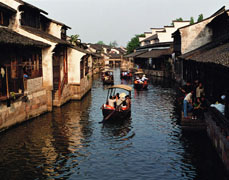 On both sides of a slabstone-paved street stand pubs, restaurants, pawnshops, weaving and dyeing establishments, and other businesses, all housed in wooden structures of brown. Rivers and creeks spanned with stone bridges in various designs flow through the town, and the Beijing-Hangzhou Grand Canal passes by. Old waterside houses and outside corridors can be found here and there. This is the ancient town of Wuzhen.
On both sides of a slabstone-paved street stand pubs, restaurants, pawnshops, weaving and dyeing establishments, and other businesses, all housed in wooden structures of brown. Rivers and creeks spanned with stone bridges in various designs flow through the town, and the Beijing-Hangzhou Grand Canal passes by. Old waterside houses and outside corridors can be found here and there. This is the ancient town of Wuzhen.
Wuzhen Town, in Tongxiang City, Zhejiang Province, has a history of more than 1,000 years. Of the ancient residential houses, workshops, and stores still standing on the banks of the rivers, 169,600 square meters, accounting for 81.54 percent of the town's total floor area, have remained unchanged, lending an atmosphere of antiquity.
Wuzhen has many sites of historical and cultural interest. From the Song (960-1279) through the Qing (1644-1911) Dynasties, Wuzhen produced more successful candidates in the highest imperial examinations than any other town south of the lower reaches of the Changjiang (Yangtze) River. Bearing witness to the town's emphasis on education is the Lizhi (Aspiration) Academy of Classical Learning of the Qing Dynasty, which still retains its original appearance.
During the Northern and Southern Dynasties (420-581), Crown Prince Liang Zhaoming once studied at Wuzhen. The prince is famous for his Literary Selections by Zhaoming, a milestone in the history of Chinese literature, and the town of Wuzhen built a memorial archway to commemorate his stay there and has kept it well preserved. Other historical and cultural sites include the Wenchang Pavilion, the Xiuzhen Taoist Temple, the ancient stage, the mansion of a member of the Imperial Academy, and the former residence of Mao Dun, a great master of contemporary Chinese literature.
Tradition is still very much alive in Wuzhen. In addition to flower-drum opera, shadow-puppet shows, and temple fairs, Wuzhen also attracts visitors with its time-honored art of making indigo-dyed printed calico. In ancient times, indigo-dyed printed calico was used for curtains, scarves, and tablecloths in every household in the countryside of Zhejiang Province. Today, it is still common to see old women in indigo-blue gowns leisurely operating spinning wheels or looms at weaving workshops in the old lanes of Wuzhen, while the squeaks of the looms resound throughout the lanes. Carrying on this tradition has become a part of the lives of the old women.
The raw material for dye printing is Eupatorium fortunei, a herb that turns into indigo after being fermented and precipitated. For convenience in transporting the cloth, the weaving workshops and dyeing workshops are usually on the same street, only a few doors from each other. At the dyeing workshop, the cloth is soaked and air-dried again and again to produce white flowers on a blue background.
Wuzhen is at its best on rainy days. Strolling with an umbrella along an old lane past the centuries-old wooden houses and seeing the rain flow off the engraved eaves that cover the doorways is an amazing experience. The falling raindrops bring ripples on the river surfaces, while boats travel to and fro. The waterside pavilions and corridors and the arched bridges, all shrouded in drizzle, make up a charming scene.
People in Wuzhen live a simple life. Many of them breed silkworms and raise chrysanthemums, and they have mostly retained the tradition of buying fruit and vegetables from trade boats through the windows of their waterside houses. They benefit from an inherited harmony of man and nature and enjoy the pleasing living environment that comes from social progress. In May 1999, the local government invested 200 million yuan for maintaining and improving the town's environment. The project was to be completed within five years, and the first phase, with an investment of 80 million yuan, was completed by the end of 2001.
While taking care to retain the town's original look, efforts have been made in the treatment of the water environment, the renovation of public toilets, the installation of outdoor lighting, and the management of the sanitation and appearance of the town. A clean, beautiful environment has thus been ensured.
Wuzhen has been included by UNESCO in the reserve list of world cultural heritages.
(China Pictorial March 21, 2003)
|

